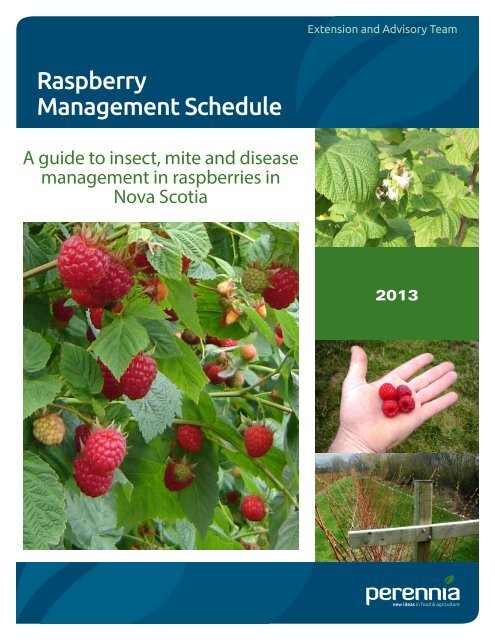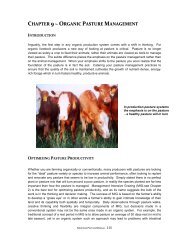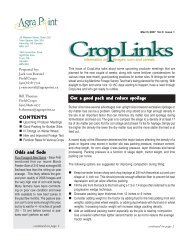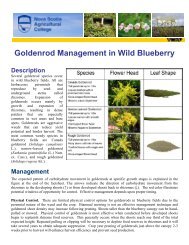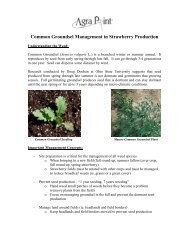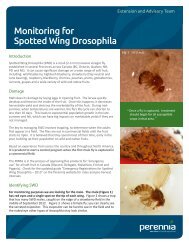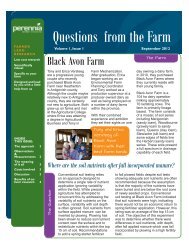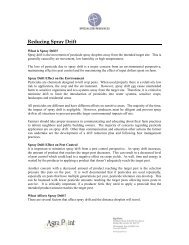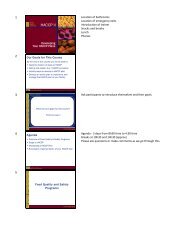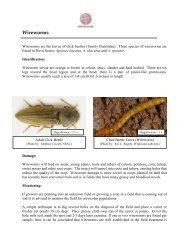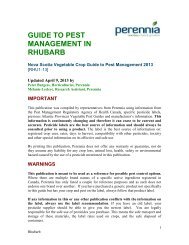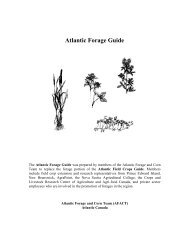Raspberry Insect & Disease Management Schedule - Perennia
Raspberry Insect & Disease Management Schedule - Perennia
Raspberry Insect & Disease Management Schedule - Perennia
You also want an ePaper? Increase the reach of your titles
YUMPU automatically turns print PDFs into web optimized ePapers that Google loves.
Extension and Advisory Team<br />
<strong>Raspberry</strong><br />
<strong>Management</strong> <strong>Schedule</strong><br />
A guide to insect, mite and disease<br />
management in raspberries in<br />
Nova Scotia<br />
2013
<strong>Raspberry</strong> <strong>Insect</strong> & <strong>Disease</strong> <strong>Management</strong> <strong>Schedule</strong><br />
RASPBERRY INSECT & DISEASE MANAGEMENT SCHEDULE<br />
FOR NOVA SCOTIA<br />
Nova Scotia Guide to Pest <strong>Management</strong> in <strong>Raspberry</strong> 2013<br />
[Rasp 2-13]<br />
Authors<br />
Rick Delbridge, Plant Pathologist, Delbridge <strong>Disease</strong> <strong>Management</strong><br />
Dick Rogers, Entomologist, Wildwood Labs Inc.<br />
Updated May 13, 2013 by<br />
Peter Burgess, Horticulturist, <strong>Perennia</strong><br />
Melanie Leclerc, Research Assistant, <strong>Perennia</strong><br />
Agdex No. 237/605<br />
LIABILITY STATEMENT<br />
Recommendations in this guide are given for general information only<br />
and do not give the user the right to use a product in a manner not in<br />
accordance with the pesticide label or Pest Control Products Act.<br />
<strong>Perennia</strong>, by funding and printing this publication, and the<br />
editors/authors, do not offer any warranty or guarantee and do not<br />
assume any liability for crop loss, animal loss, health, safety, or<br />
environmental hazard caused by the use of any pesticide, advice, or<br />
recommendation in this schedule. Pesticides used in this schedule are<br />
products labeled for the target and crop. This information was retrieved<br />
from the Pest <strong>Management</strong> Regulatory online of Registered Products<br />
Database. The list of products presented in this schedule is intended to<br />
be complete, based on products known to be available in the region,<br />
but in no way is guaranteed to be complete. Some of the products<br />
listed may not be available. Trade names are given as a convenience to<br />
producers and are neither an endorsement of the product nor a<br />
suggestion that similar products are not available or effective.<br />
ACKNOWLEDGEMENTS<br />
Advice & Review:<br />
Dr. Rob Smith, Research Entomologist, retired<br />
Agriculture and Agri-Food Canada, Kentville, NS.<br />
Dr. Paul Hildebrand, Research Scientist<br />
Agriculture and Agri-Food Canada, Kentville, NS.<br />
Review:<br />
John Lewis, Fruit Crops Horticulturist<br />
<strong>Perennia</strong>, Kentville, NS.<br />
i
<strong>Raspberry</strong> <strong>Insect</strong> & <strong>Disease</strong> <strong>Management</strong> <strong>Schedule</strong><br />
CONTENTS<br />
Liability Statement ………………………………..……………………………. i<br />
Acknowledgements ……………………………………...…...………………… i<br />
Pesticide Emergency Contact Information<br />
iii<br />
Abbreviations and Conversions<br />
iii<br />
Toxicity Table<br />
iv<br />
Emergency and First-Aid Procedures for Pesticide Poisoning<br />
iv<br />
<strong>Raspberry</strong> <strong>Insect</strong> & <strong>Disease</strong> <strong>Management</strong> <strong>Schedule</strong> ……..…………………….. 1<br />
Site Selection & Preparation ……………..…………………………. 1<br />
Soil Fumigation ………………………..……...……………………. 1<br />
Established Plantings ………………….……………………………. 2<br />
Occasional Pests..…………………………………………………… 8<br />
Pesticide Information Summary ………………………………………..………. 10<br />
Label Definitions ………………………………………..……………………… 11<br />
How to Reduce / Avoid Pesticide Use …………………………………………. 12<br />
ii
<strong>Raspberry</strong> <strong>Insect</strong> & <strong>Disease</strong> <strong>Management</strong> <strong>Schedule</strong><br />
PESTICIDE EMERGENCY CONTACT INFORMATION<br />
Poison Control Centres<br />
Nova Scotia<br />
1.800.565.8161 or Regional Poison Centre, Halifax, NS<br />
1.902.470.8161 or 911<br />
New Brunswick 911 Ask for Poison Information<br />
Prince Edward Island 1.800.565.8161 or Regional Poison Centre, Halifax, NS<br />
1.902.470.8161<br />
Newfoundland<br />
709.722.1110 or<br />
1.866.727.1110<br />
Dr. Charles A. Janeway<br />
Child Health Care Centre,<br />
St. John’s, NF<br />
Environmental Emergencies (Pesticide Spills)<br />
Transport Canada Regional Operations Centre (24 hours)<br />
Nova Scotia 1.800.565.1633<br />
New Brunswick 1.800.565.1633<br />
Prince Edward Island 1.800.565.1633<br />
Newfoundland 1.800.563.9089<br />
ABBREVIATIONS & CONVERSIONS<br />
Formulation, and Measurement Abbreviations<br />
DF Dry flowable g gram<br />
EC, E, EW Emulsifiable concentrate kg kilogram<br />
EG Water dispersible granule kPa kiloPascal<br />
L Liquid l litre<br />
WDG Wettable dry granule ml millilitre<br />
WP or W Wettable powder BIU Billions of International Units<br />
SC Suspension concentrate ppm Parts per million<br />
Label Abbreviations<br />
PHI<br />
REI<br />
Pre-Harvest Interval<br />
Restricted Entry Interval<br />
Helpful Conversions*<br />
kPa X 0.14 = pounds per square inch (psi)<br />
hectares X 2.47 = acres<br />
kilograms X 2.2 = pounds<br />
kilograms per hectare X 0.89 = pounds per<br />
acre<br />
kilograms per hectare X 0.40 = kilograms per<br />
acre<br />
millilitres X 0.035 = fluid ounces<br />
litres X 35 = fluid ounces<br />
litres X 0.22 = imperial gallons<br />
litres per hectare X 14.17 = fluid ounces per<br />
acre<br />
litres per hectare X 0.40 = litres per acre<br />
* Pesticide Units of Measurement<br />
It is not recommended to convert label rates to imperial units because there is a high likelihood of<br />
mathematical errors creeping in to the results. Present day pesticides are formulated to have greater toxic<br />
effects in smaller amounts. Therefore, even small conversion errors can lead to the use of incorrect<br />
dosages (either too high or too low). Use metric – you will be glad you did!<br />
iii
<strong>Raspberry</strong> <strong>Insect</strong> & <strong>Disease</strong> <strong>Management</strong> <strong>Schedule</strong><br />
Toxicity Table<br />
LD 50 (mg/kg) Hazard Rating Relative Toxicity Rating<br />
Above 500 Very Low Hazard 1<br />
101-500 Low Hazard 2<br />
21-100 Moderate Hazard 3<br />
11-20 Very High Hazard 4<br />
10 and less Extremely Hazardous 5<br />
Emergency and First-Aid Procedure for Pesticide Poisoning<br />
· Become familiar with the chemicals you are using. Keep a list<br />
of common names in case of accidents or emergencies. This<br />
information can be found on product labels cross-referenced in<br />
this publication.<br />
· If a pesticide has come in contact with the skin or has been<br />
spilled on clothing, remove the clothing and wash the skin<br />
thoroughly with soap and warm water.<br />
· If a person suspects poisoning from exposure to a pesticide by<br />
swallowing, inhalation or contact with skin or eyes, read the<br />
label of the pesticide container and carry out first-aid treatment<br />
as suggested.<br />
· Immediately after first-aid treatment has been given, wrap the<br />
patient in a coat or blanket and rush him/her to the nearest<br />
hospital. Take the list of chemical common names with you<br />
and identify the one being used.<br />
· If a person is unconscious or lapses into unconsciousness, call<br />
911 immediately.<br />
· Emergency advice on pesticide poisoning is available from the<br />
Regional Poison Centre, Halifax, NS. Phone 1-800-565-8161<br />
(NS & PEI).<br />
iv
<strong>Raspberry</strong> <strong>Insect</strong> & <strong>Disease</strong> <strong>Management</strong> <strong>Schedule</strong><br />
<strong>Raspberry</strong> <strong>Insect</strong> & <strong>Disease</strong> <strong>Management</strong> <strong>Schedule</strong><br />
Site Selection & Preparation<br />
<strong>Insect</strong> / <strong>Disease</strong><br />
White Grubs<br />
Wireworms<br />
<strong>Raspberry</strong> Crown<br />
Borer<br />
Root Weevils<br />
Strawberry Bud<br />
Weevil<br />
Phytophthora<br />
Root Rot<br />
Verticillium Wilt<br />
Nematodes<br />
Note<br />
Do not plant raspberries on land that has recently been in sod or in fields<br />
known to have a wireworm or white grub problem.<br />
Crown borers, root weevils, and bud weevils can be a problem in old<br />
plantings and may pose a threat to nearby new plantings. Avoid planting<br />
near old plantings. Remove wild brambles from area surrounding<br />
commercial fields. See Established Plantings and Occasional Pests<br />
sections.<br />
Avoid poorly drained soils and fields with a history of this disease. Do not<br />
introduce the disease to clean fields by planting infected plants. Planting<br />
tissue culture plants produced in soilless culture can prevent introduction of<br />
this disease into the field. Purchase certified planting stock. Research<br />
indicates that a 30 cm high raised row effectively reduces root rot severity.<br />
In some areas, however, this may result in increased risk of winter injury to<br />
roots. No commercial cultivars adapted to the Atlantic region have adequate<br />
resistance to Phytophthora root rot. Ridomil Gold is registered as a spring<br />
and fall treatment on new beds and as a fall treatment on established beds.<br />
Aliette is registered for spring and fall treatments. Phostrol can be used for<br />
preventative suppression of phytophthora root rot in new plantings; begin<br />
applications when the plants produce new growth of 1-3 inches. See<br />
Occasional Pests section.<br />
Do not plant raspberries following potatoes or alfalfa or where Verticillium<br />
is known to occur. Effective control can be achieved with soil fumigation.<br />
Several nematode species have been associated with poor growth of<br />
raspberries. The root lesion nematode is the most important with a threshold<br />
of 500-1000 nematodes per kilogram of dry soil. Summer fallowing the<br />
year before planting will reduce nematode populations. In the fallow year,<br />
cultivate every few weeks during the summer to kill young weeds and to<br />
desiccate nematodes. Crop rotations using fall fescue, brome grass, or rye<br />
grass are less likely to increase nematode populations than crops such as<br />
soybeans, corn and clovers. Effective control of nematodes can also be<br />
achieved with soil fumigation.<br />
Soil Fumigation<br />
<strong>Insect</strong>/<strong>Disease</strong> Product Rate/ha Note<br />
Nematodes Pic Plus<br />
Fumigant<br />
Chloropicrin<br />
108 L<br />
93 L<br />
Broadcast application only. For control of root<br />
knot and root lesion nematodes. Read label for<br />
application instructions<br />
100<br />
Verticillium<br />
Wilt<br />
Vapam 470-900<br />
L<br />
May be applied with an irrigation system. See<br />
label for directions. Some fumigants will also<br />
suppress certain weeds and control soil insects<br />
such as wireworms and white grubs.<br />
1
<strong>Raspberry</strong> <strong>Insect</strong> & <strong>Disease</strong> <strong>Management</strong> <strong>Schedule</strong><br />
Pic Plus 108 L Broadcast application only. Also for Phytophtora.<br />
Fumigant<br />
Read label for application instructions<br />
Chloropicrin 93 L<br />
100<br />
FUMIGATION should be done in September or early October in the fall prior to spring planting.<br />
Previous crop debris must be cultivated into the soil during the summer so that it is fully<br />
decomposed at the time of fumigation. One week prior to fumigation, till the soil to a depth of at<br />
least 25 cm to break clods and loosen the soil. The soil should be moist but not wet. Inject<br />
fumigant 15 to 20 cm deep and drag immediately to fill injector shank slits. Seal by rolling,<br />
cultipacking, covering treated area with a plastic tarpaulin or with a light irrigation. For Vapam<br />
only, apply via sprinkler irrigation. Apply a minimum of 25mm of water per hectare. For fall<br />
fumigation, the soil can be left undisturbed until spring. Cultivate several times in the spring at<br />
one week intervals prior to planting to allow complete aeration of the soil. Heavy, wet, cold soils<br />
require longer to fully aerate. To prevent contamination do not cultivate deeper than the injection<br />
depth. Do not plant if you can still smell the fumigant. Read the label completely before handling<br />
fumigants. Follow all safety precautions.<br />
Established Plantings<br />
<strong>Insect</strong> /<br />
<strong>Disease</strong><br />
Product 1 Rate / ha Note<br />
Green Tip (buds showing green tips not more than 1 cm in length)<br />
Spur Blight /<br />
Anthracnose<br />
lime sulfur 3.5 L /<br />
100L<br />
Use with enough water volume to drip off plants<br />
(1000-1500 L/ha). Do not apply beyond 1 cm<br />
green tip due to possible burning, particularly<br />
under warmer temperatures.<br />
New Canes 10 cm tall<br />
<strong>Raspberry</strong><br />
Crown Borer<br />
Diazinon<br />
500EC<br />
Diazinon<br />
50WP<br />
4.0 L 1.0 L/1000 L water applied at 600 mL/plant<br />
(4000 L/ha). Apply pre-bloom when new cane<br />
growth is about 10 cm above the ground.<br />
4.0 kg 1.0 kg/1000 L water applied at rate of 0.5 L/plant<br />
(4000 L/ha). Apply pre-bloom when new cane<br />
growth is about 10 cm above the ground.<br />
Bud Cluster (when blossom buds begin to separate from one another)<br />
<strong>Raspberry</strong><br />
Fruitworm<br />
Diazinon<br />
50WP<br />
4.0 kg 1.0 kg/1000 L water applied at rate of 0.5 L/plant<br />
(4000 L/ha)<br />
(Adult stage) Diazinon<br />
500EC<br />
4.0 L 1.0 L/1000 L water applied at 600 mL/plant<br />
(4000 L/ha)<br />
Malathion<br />
25WP<br />
8-10 kg 4-5 kg/1000 L water at approximately 2000<br />
L/ha; use at temperatures of 20°C or higher.<br />
Adult beetles skeletonize developing leaves and feed on buds. Larvae feed on<br />
berries.<br />
Prebloom (before blossoms open)<br />
Spur Blight / Ferbam<br />
Anthracnose 76WDG<br />
4.5 kg Apply when new canes are 30 cm high. Use<br />
2000 L of water.<br />
Tanos 50 DF 840 g Apply to foliage and fruit and repeat on a 7 day<br />
interval. Make no more than 6 applications per<br />
year. Apply in sufficient water volume to ensure<br />
thorough coverage (250-800 L/ha).<br />
2
<strong>Raspberry</strong> <strong>Insect</strong> & <strong>Disease</strong> <strong>Management</strong> <strong>Schedule</strong><br />
Anthracnose Pristine WG 1.3-1.6<br />
kg<br />
Late Yellow<br />
Rust<br />
Strawberry<br />
Bud Weevil<br />
Two-spotted<br />
Spider Mite<br />
Begin applications prior to disease development<br />
and continue on 7-14 day schedule. Use shorter<br />
interval and/or higher rates when disease pressure<br />
is high. Maximum of 4 applications per season.<br />
REI =24 hours if handling fruit, leaves or canes.<br />
Topas 250E 0.5 L Apply at first detection of disease and then 14<br />
days later. Maximum of 2 applications per year.<br />
Malathion 8-10 kg 4-5 kg/1000 L water at approximately 2000<br />
25WP<br />
L/ha; use at temperatures of 20°C or higher.<br />
Malathion 2.75 L Use at temperatures of 20°C or higher.<br />
500EC<br />
Small round holes in flower petals and clipped buds indicate the presence of<br />
this pest.<br />
Acramite<br />
50WS<br />
851 g/ha<br />
(15<br />
pouches/4<br />
ha)<br />
Maximum 1 application/year. Apply in a<br />
minimum of 500 L water/ha to ensure adequate<br />
coverage of all leaf surfaces. Primarily effective<br />
on motile stages of mites. PHI = 1 day REI = 12<br />
hours<br />
Bloom (WARNING – Spraying insecticides during bloom is hazardous to bees)<br />
Fruit Rot<br />
Captan<br />
80WDG<br />
Maestro 80DF<br />
Rovral 50WP<br />
Elevate<br />
50WDG<br />
Cantus<br />
70WDG<br />
Switch 62.5<br />
WG<br />
Pristine WG 1.3-1.6<br />
kg<br />
2.5 kg Target bloom for fruit rot sprays. Apply 2-3<br />
applications beginning at 5-10 % bloom and a<br />
2.5 kg second at full bloom. Varieties flower at<br />
different times so treat varieties separately. If<br />
2.0 kg wet weather persists make additional<br />
applications. Create an open canopy with proper<br />
1.7 kg cane densities and trellising. This improves air<br />
circulation, increases light penetration and<br />
speeds up drying of plant surfaces. See section<br />
0.56 kg on resistance. For Cantus: 7-14 day schedule just<br />
prior to disease development and no more than 4<br />
applications per year.<br />
775 to Make the first application during early bloom. A<br />
975 g second application may be made 7-10 days later.<br />
One of the actives in this product is persistent<br />
and may carryover. It is recommended that<br />
products containing fludioxonil not be used in<br />
areas treated with this product during the<br />
previous season. There is a rotation restriction<br />
on crops where this product is not registered.<br />
Begin applications prior to disease development<br />
and continue on a 7-14 day schedule. Use a<br />
shorter interval and/or higher rates when disease<br />
pressure is high. Maximum of 4 applications per<br />
season. REI =24 hours if handling the fruit,<br />
leaves or canes.<br />
Tanos 50 DF 840 g Apply to foliage and fruit and repeat on a 7 day<br />
interval. Make no more than 6 applications per<br />
year. Apply in sufficient water volume to ensure<br />
thorough coverage (250-800 L/ha).<br />
3
<strong>Raspberry</strong> <strong>Insect</strong> & <strong>Disease</strong> <strong>Management</strong> <strong>Schedule</strong><br />
<strong>Raspberry</strong><br />
Fruitworm,<br />
Thrips,<br />
Leafhoppers<br />
Obliquebanded<br />
leafroller<br />
Serenade Max 3.0-6.0<br />
kg/ha<br />
Serenade ASO 4.0-15.0<br />
L/ha<br />
Malathion<br />
25WP<br />
Surround WP 12.5-25<br />
kg/ha<br />
Delegate WG 0.1-0.2<br />
kg/ha<br />
Bioprotec 3P<br />
NEW 2012<br />
Serenade MAX and Serenade ASO are<br />
biopesticides that may only suppress the<br />
indicated diseases. Begin applications at first<br />
sign of the disease or when conditions become<br />
conducive for disease development. Repeat as<br />
necessary on a 7-10 day interval. May also<br />
control Bacterial blight (see product label).<br />
8-10 kg Highly toxic to bees. 4-5 kg/1000 L water at<br />
approximately 2000 L/ha; use at temperatures of<br />
20°C or higher. PHI = 1 day<br />
0.72-1.45<br />
kg/ha<br />
Dipel 2X DF 525-1125<br />
g/ha<br />
Fireblight BlightBan C9-<br />
1<br />
Two-spotted<br />
Spider Mite<br />
Bloomtime<br />
Biological FD<br />
Biopesticide<br />
Acramite<br />
50WS<br />
370-500<br />
g/ha<br />
375 – 500<br />
g/ha<br />
851 g/ha<br />
(15<br />
pouches/4<br />
ha)<br />
This is an OMRI listed control product and is<br />
suitable for organic production. Apply in 500<br />
L of water. Apply at 7-14 day intervals once<br />
initial infestation is detected. Use high rate for<br />
early applications. Do not exceed 25 kg per<br />
hectare per application. Aster Leafhoppers<br />
only.<br />
Apply at egg hatch to small larvae. Use higher<br />
rate for larger larvae or bigger populations.<br />
Apply a maximum of 3 applications per year.<br />
REI = 5 days<br />
Foliar application - apply at first signs of<br />
infestation when larvae are small. Repeat<br />
applications, according to economic threshold, as<br />
necessary to maintain control. Minimum reapplication<br />
interval is 7 days. Thorough coverage<br />
of all foliage is essential. Apply in a minimum of<br />
600 L water/ha.<br />
Treat when larvae are young, before the crop is<br />
damaged. Repeat applications at an interval<br />
sufficient to maintain control, 3-14 days. Spray<br />
volume of 600 L water/ha.<br />
Bio-pesticide for fireblight suppression. Apply<br />
in 1000-2000 L of water/ha. Maximum of 3<br />
applications per year. First application at 15-<br />
20% bloom, followed by a second application at<br />
full bloom. Use high rate under high disease<br />
pressure.<br />
For suppression only. Apply in 1000-2000 L of<br />
water per hectare. Apply a maximum of two<br />
applications per year. First application at 15-<br />
20% bloom; second at full bloom to petal fall.<br />
PHI = 0 days<br />
Maximum of 1 application per year. Apply in<br />
a minimum of 500 L water/ha to ensure adequate<br />
coverage of all leaf surfaces. Primarily effective<br />
on motile stages of mites. PHI = 1day REI = 12<br />
hours<br />
4
<strong>Raspberry</strong> <strong>Insect</strong> & <strong>Disease</strong> <strong>Management</strong> <strong>Schedule</strong><br />
Postbloom<br />
Two-spotted<br />
Spider Mite<br />
Apollo 500SC 500 mL Use when mites become a problem. Monitor to<br />
determine mite developmental stages before<br />
using. Apply when mites are mostly in the egg<br />
stage; it is effective against eggs & nymphs but<br />
not adults. Maximum of 1 application per<br />
season. Use 500-1000 L water/ha.<br />
Acramite<br />
50WS<br />
851 g/ha<br />
(15<br />
pouches/4<br />
ha)<br />
Maximum of 1 application/year. Apply in a<br />
minimum of 500 L/ha to ensure adequate<br />
coverage of all leaf surfaces. Primarily effective<br />
on motile stages of mites. PHI = 1day REI = 12<br />
hours<br />
Aphids Admire 240 175 ml/ha Apply up to 3 times per season in 200L of water<br />
/ha as a foliar spray. Do not apply pre-bloom or<br />
during bloom or when pollinators are actively<br />
foraging. If multiple applications are required<br />
allow 7 days between applications. PHI = 4 days<br />
Leafhoppers Admire 240 175 ml/ha Apply up to 3 times per season in 200L of water<br />
/ha as a foliar spray. Do not apply pre-bloom or<br />
during bloom or when pollinators are actively<br />
foraging. If multiple applications are required<br />
allow 7 days between applications. PHI = 4 days<br />
(Suppression only)<br />
Surround WP 12.5-25<br />
kg/ha<br />
This is an OMRI listed control product and is<br />
suitable for organic production. Apply in 500<br />
L of water. Apply at 7-14 day intervals once<br />
initial infestation is detected. Use high rate for<br />
early applications. Do not exceed 25 kg/ha per<br />
application. Aster Leafhoppers only<br />
Cane Borers Admire 240 467 ml/ha Apply when evidence of cane borer activity is<br />
noted (wilted cane tips, swelling near base of<br />
canes, eggs in slits in base of canes). Apply up to<br />
3 times/season in 200L of water/ha as a foliar<br />
spray. Do not apply pre-bloom or during<br />
bloom or when pollinators are actively<br />
foraging. If multiple applications are required<br />
allow 7 days between applications. PHI = 4<br />
(Suppression only)<br />
Cane borers<br />
and Crown<br />
borers<br />
Altacor 215-285<br />
g/ha<br />
Apply to first instar when they are actively<br />
feeding in the cambium before they tunnel into<br />
the root, crown or canes. Apply in a minimum of<br />
500 L/ha. Maximum of 3 applications per<br />
season. Maximum of 645g/ha per season. It is<br />
recommended that products containing<br />
chlorantraniliprole not be used in areas treated<br />
with this product during the previous season. Do<br />
not apply more than once every 14 days.<br />
Caution should be taken when applying near<br />
bloom. PHI = 3 days<br />
5
<strong>Raspberry</strong> <strong>Insect</strong> & <strong>Disease</strong> <strong>Management</strong> <strong>Schedule</strong><br />
White Grubs<br />
(Larvae of<br />
European<br />
Chafer)<br />
Fireblight BlightBan C9-<br />
1<br />
Admire 240 1.2 L/ha Ground application only (soil drench). Apply<br />
in 200 L of water/ha. Apply just prior to or<br />
during egg hatch. Application should be based<br />
on previous populations, monitoring and adult<br />
trapping. Do not apply pre-bloom or during<br />
bloom or when pollinators are actively<br />
foraging. Irrigate 5 – 10 mm within 24 hours after<br />
application to move the active ingredient to the root<br />
zone. Over watering (more than 20 mm) must be<br />
avoided. Apply only once per season as a soil<br />
drench. PHI = 14 days<br />
370-500<br />
g/ha<br />
Bio-pesticide for fireblight suppression. Apply<br />
in 1000-2000 L of water/ha. Maximum of three<br />
applications per year. First at 15-20% bloom,<br />
second at full bloom and third application<br />
immediately at post bloom.<br />
Preharvest<br />
Fruit Rot Same as for Bloom period Apply if wet weather persists during the ripening<br />
period.<br />
Aphids<br />
Leafhoppers<br />
Caneborers<br />
Postharvest<br />
Spur Blight /<br />
Anthracnose<br />
Same as Post Bloom period<br />
Same as Post Bloom period<br />
Same as Post Bloom period<br />
Ferbam 76<br />
WDG<br />
4.5 kg Apply immediately after harvest. Pruning out<br />
fruiting canes after harvest is also beneficial in<br />
reducing disease pressure.<br />
Tanos 50 DF 840 g Apply to foliage and fruit and repeat on a 7 day<br />
interval. Maximum of 6 applications per year.<br />
Apply in sufficient water volume to ensure<br />
thorough coverage (250-800 L/ha).<br />
Anthracnose Pristine WG 1.3-1.6<br />
kg/ha<br />
Two-spotted<br />
Spider Mite<br />
Agri-Mek 1.9%<br />
EC<br />
Begin applications prior to disease development<br />
and continue on a 7-14 day schedule. Use a<br />
shorter interval and/or higher rates when disease<br />
pressure is high. Maximum of 4 applications per<br />
season. REI =24 hours if handling the fruit,<br />
leaves or canes.<br />
1 L The manufacturer “makes no representation or<br />
warranty with respect to performance (efficacy)<br />
and/or crop tolerance (phytotoxicity) claims for<br />
this product when used to control two-spotted<br />
spider mites in caneberries.”<br />
6
<strong>Raspberry</strong> <strong>Insect</strong> & <strong>Disease</strong> <strong>Management</strong> <strong>Schedule</strong><br />
Aphids<br />
Leafhoppers<br />
Caneborers<br />
Nexter 75WP<br />
(Pyramite)<br />
Acramite<br />
50WS<br />
600 g/<br />
3000 L<br />
851 g/ha<br />
(15<br />
pouches/4<br />
ha)<br />
Same as Post Bloom period<br />
Same as Post Bloom period<br />
Same as Post Bloom period<br />
600g based on 3000 L/ha. This rate of water is<br />
considered high for raspberries and, if delivered,<br />
would result in a significant loss of product to<br />
runoff. Normally 2000 L is sufficient as a dilute<br />
spray in raspberry, in which case the 600 g/ha<br />
(200 g/1000 L) could be adjusted accordingly.<br />
Nexter is effective against immature stages of<br />
two-spotted spider mite. At postharvest, mites<br />
will be in all stages, including many in the adult<br />
stage.<br />
Maximum of 1 application per year. Apply in<br />
a minimum of 500 L/ha to ensure adequate<br />
coverage of all leaf surfaces. Primarily effective<br />
on motile stages of mites. PHI = 1 day REI = 12<br />
hours<br />
1 Refer to the Pesticide Information Summary table for a list of trade names and common chemical names.<br />
2 Unless otherwise stated, use at least 2000 L water per hectare.<br />
7
<strong>Raspberry</strong> <strong>Insect</strong> & <strong>Disease</strong> <strong>Management</strong> <strong>Schedule</strong><br />
Occasional Pests<br />
<strong>Insect</strong> / <strong>Disease</strong><br />
<strong>Disease</strong>s<br />
Late Yellow Rust<br />
Fireblight<br />
Virus <strong>Disease</strong>s<br />
Crown Gall<br />
Powdery Mildew<br />
Note<br />
Remove alternate host (white spruce). Nova and K81-6 have significant<br />
resistance. Boyne has partial resistance.<br />
A recent problem in the Maritimes, especially on the cultivars K81-6 and<br />
Boyne. Remove and destroy diseased canes. Disinfect pruning shears<br />
between each cut. Do not over fertilize as vigorous succulent growth is very<br />
susceptible. Destroy wild brambles in the immediate vicinity. Purchase<br />
certified planting stock.<br />
Raspberries are susceptible to many virus diseases. Mosaic, leaf curl and<br />
crumbly berry are the most common. Mosaic and leaf curl are spread by<br />
aphids while crumbly berry is spread by the dagger nematode. Rogue out<br />
affected plants. Use certified nursery stock. Destroy nearby wild brambles.<br />
Do not plant new plantings near old ones.<br />
Do not plant canes infected with crown gall. Avoid injury to the crown and<br />
roots of plants and maintain good soil fertility.<br />
This disease is seldom a problem. Senator 70WP 1.1 kg/ha may provide<br />
some control.<br />
Phytophthora Root<br />
Rot<br />
Cane Botrytis<br />
<strong>Insect</strong>s*<br />
<strong>Raspberry</strong> Cane<br />
Borer<br />
Nova 40W – Apply at first sign of disease at a rate of 340 g/ha. Do not<br />
apply more than 340 g/ha per season. 6 day PHI; There is an 8 day REI for<br />
hand setting of irrigation line and a 6 day REI for harvesting training and<br />
tying. 12 hours REI for all other activities.<br />
Ridomil Gold 480EC - On established plantings, apply 37 mL per 100 m<br />
of row to the soil surface in a one meter wide band centred over the row (do<br />
not apply in the spring). Apply one application prior to freeze-up (no later<br />
than November 30). On new plantings, apply in the spring after planting<br />
and again in the fall using the above rate. Do not apply later than November<br />
30. Time applications prior to rain or irrigation.<br />
Aliette 80 WDG - can be applied as a foliar application up to four times per<br />
year at 5.5 kg/ha to bearing and non-bearing raspberries. Apply in the fall<br />
when conditions favor disease. Repeat in 3 to 4 weeks. Last application<br />
must be 30 days prior to leaf drop. Apply Aliette in the spring when there is<br />
7 cm of new growth and repeat in 3 to 4 weeks. Consider using raised rows.<br />
PHI is 60 days.<br />
Phostrol – Apply at a rate of 5.2 L/ha in new plantings when plants produce<br />
new growth of 1-3 inches. Continue on a 45-60 day interval. In fall shorten<br />
interval to 21-28 days. Apply in 400Lof water/ha. Maximum of 4<br />
applications per season. PHI = 1 day REI = 12 hours<br />
Cane Botrytis is caused by the same fungus that causes grey mold fruit rot.<br />
It attacks primocanes from mid-late summer to early fall. Wide rows and<br />
dense canopies favor the disease. Fungicides used for Botrytis fruit rot will<br />
help control cane Botrytis if the spray is directed at the entire cane. Tanos<br />
50DF, 840g/ha is registered for spur blight, anthracnose, Botrytis fruit<br />
rot, as well as cane Botrytis. Tanos may be used post-bloom and postharvest<br />
for cane Botrytis control. Maximum of 6 applications per year.<br />
Canes are girdled near the tip by 2 rings approximately 12 mm apart and<br />
12-20 cm from a lateral tip. Cut off wilted tips below the rings in June &<br />
8
<strong>Raspberry</strong> <strong>Insect</strong> & <strong>Disease</strong> <strong>Management</strong> <strong>Schedule</strong><br />
<strong>Raspberry</strong><br />
Crown Borer<br />
Root Weevils<br />
<strong>Raspberry</strong> Sawfly<br />
<strong>Raspberry</strong> Bud<br />
Moth<br />
Brown<br />
marmorated stink<br />
bug<br />
July. Note: Altacor registration for cane and crown borer listed in post<br />
bloom timing above.<br />
Remove wild brambles from the area. Apply Altacor to first instar when<br />
they are actively feeding in the cambium before they tunnel into the root,<br />
crown or canes. Apply in a minimum of 500 L/ha. Maximum of 3<br />
applications per season. Maximum of 645g/ha per season. Do not apply<br />
more than once every 14 days. PHI = 3 days<br />
Another alternative is to apply Diazinon 500EC (or 50WP) as a drench to<br />
the crown area using 600 mL of the mixture per plant (4000 L per hectare).<br />
Apply pre-bloom when new cane growth is about 10 cm above the ground.<br />
Different species of weevils feed on raspberry but the black vine weevil is<br />
the most common. Larvae feed on roots and crowns. Damage is suspected<br />
when adults feed on foliage producing characteristic notching (July &<br />
August).<br />
NEW 2013: Actara 25WG: Apply at 210-280 g/ha. Maximum 2<br />
applications per season. Apply as a foliar application by broadcast spray<br />
before pests reach damaging levels. Scout fields and treat again if<br />
populations rebuild to potentially damaging levels. PHI = 3 days.<br />
The pale green sawfly larvae feed on the outer edge of leaves chewing out<br />
irregular holes and in some cases skeletonizing the foliage. Sprays timed to<br />
control raspberry fruitworm will also control sawfly.<br />
In the spring, the small, bright-red caterpillars emerge from the soil, climb<br />
up fruiting canes and tunnel into buds and laterals. There are no registered<br />
chemicals to control raspberry bud moth. Sanitation practices, such as<br />
removing and burning cane debris, will help. This pest is of particular<br />
concern in Newfoundland and is known to occur in NB. Nova Scotia is in<br />
the distribution zone so producers should be on the outlook for it.<br />
Malathion 85E – Apply at 1345 mL/ha. Maximum of 2 applications.<br />
Ensure sufficient water volume is used to guarantee thorough coverage. Use<br />
a minimum of 500 L of water per hectare. Apply prior to harvest when<br />
treatment thresholds have been reached, as determined by local monitoring.<br />
PHI = 1 day<br />
NEW 2012<br />
* A thorough survey/inventory of raspberry insects in Nova Scotia has not been compiled and published.<br />
Therefore, it is highly advisable to monitor the crop for insects, learn more about insect identification, and<br />
be aware to potential problems and new pest species.<br />
9
<strong>Raspberry</strong> <strong>Insect</strong> & <strong>Disease</strong> <strong>Management</strong> <strong>Schedule</strong><br />
PESTICIDE INFORMATION SUMMARY<br />
(Read product label for re-entry intervals, precautions, and other product specific details)<br />
TOXICITY<br />
COMMON TRADE DAYS TO<br />
TO PRED<br />
TO APPLICATOR<br />
NAME NAMES HARVEST<br />
TO BEES<br />
MITES*<br />
ORAL DERMAL<br />
abamectin Agri-Mek<br />
For postharvest<br />
only low high mod low<br />
Bacillus subtilus<br />
Serenade<br />
Max<br />
0 low mod low low<br />
Bacillus<br />
Foray, Dipel 2X<br />
thuringiensis DF, Bioprotec<br />
0 - low low low<br />
bifenazate Acramite 1 high mod low low<br />
boscalid<br />
Lance,<br />
Cantus<br />
0 - low low low<br />
boscalid,<br />
pyraclostrobin<br />
Pristine 0 - low low low<br />
captan<br />
Captan,<br />
Maestro<br />
2 low low low low<br />
chlorantraniliprole Altacor 3 low mod low low<br />
chloropicrin<br />
Pic Plus,<br />
Chloropicrin100<br />
- ? ? high high<br />
clofentezine Apollo 15 low low low low<br />
cyprodinil,<br />
fludioxonil<br />
diazinon<br />
famoxadone /<br />
cymoxanil<br />
Switch 1 - - low low<br />
Diazinon<br />
DO NOT use<br />
after bloom mod high mod mod<br />
Tanos 0 low low low low<br />
fenhexamid Elevate 1 - low low low<br />
ferbam<br />
Ferbam<br />
DO NOT use<br />
after berries<br />
begin to form<br />
low low low low<br />
fosetyl-al Aliette 60 - low low low<br />
imidacloprid<br />
Admire<br />
4 (foliar)<br />
14 (drench) mod high low low<br />
iprodione Rovral 1 - low low low<br />
kaolin Surround - low low low low<br />
lime sulfur<br />
Lime Sulfur<br />
DO NOT use<br />
after 6 mm<br />
green<br />
high low low low<br />
malathion Malathion 1 low high low low<br />
metalaxyl-M<br />
mono- and<br />
dibasic sodium,<br />
potassium, and<br />
ammonium<br />
phosphites<br />
Pantoea<br />
agglomerans<br />
strain C9-1<br />
Pantoea<br />
agglomerans<br />
strain E325<br />
Ridomil Gold<br />
Postharvest but<br />
no later than<br />
Nov 30<br />
- low low low<br />
Phostrol 1 ? low ? ?<br />
BlightBan<br />
C9-1<br />
Bloomtime<br />
Biological FD<br />
Biopesticide<br />
- low low low low<br />
0 low low low low<br />
propiconazole Topas 30 low low low low<br />
pyridaben Nexter<br />
For postharvest<br />
only mod - mod low<br />
spinetoram Delegate WG 1 low high low low<br />
10
<strong>Raspberry</strong> <strong>Insect</strong> & <strong>Disease</strong> <strong>Management</strong> <strong>Schedule</strong><br />
Thiamethoxam Actara 3 low high low low<br />
thiophanatemethyl<br />
Senator 1 low low low low<br />
metam<br />
Vapam<br />
Preplant in the<br />
fall - - high high<br />
* Various beneficial species. If the commercially available organophosphate resistant strain of Amblyseius<br />
fallacis is used, then the toxicity of organophosphates to this species can be considered to be low.<br />
LABEL DEFINITIONS<br />
DAYS TO HARVEST - Is the minimum number of days from the last application of the product to first<br />
harvest. This interval has been set to ensure that any residue of the pesticide left on the fruit at harvest is<br />
within an acceptable tolerance. Read the label and do not spray nearer to harvest, or later than the growth<br />
stage recommended.<br />
TOXICITY TO BEES - Bees are important pollinators of raspberries. If a pesticide must be applied<br />
during the bloom period, choose products with the least toxicity to bees. Spray in late evening or early<br />
morning when bees are not present. Spray deposit should be dry before bees begin foraging. If you have<br />
rented bees, notify the beekeeper that you intend to spray. Give enough advance notice so that the bees can<br />
be moved. Do not allow pesticide spray to drift onto hives. The presence of large numbers of dead bees at<br />
the hive entrance may be an indicator of pesticide poisoning.<br />
TOXICITY TO PREDATORY MITES – Two-spotted spider mites are a common pest of raspberries.<br />
Predatory mites help suppress two-spotted spider mite infestations. When possible, choose products and use<br />
patterns with the least toxicity to these beneficial mites.<br />
TOXICITY TO APPLICATOR - Poisoning as a result of pesticide exposure can result from inhalation,<br />
ingestion (Oral), or absorption through the skin (Dermal). It is essential that protective clothing, respirator<br />
and eye protection are worn when handling products listed as having a high or moderate toxicity. However,<br />
since pesticides may also have adverse affects after long term sublethal exposures it is recommended that<br />
protective equipment be worn when using all pesticides. Some of the wettable powder (W or WP)<br />
formulations recommended in this guide are now available in low exposure packaging (Instapak, Solupak)<br />
or low dust formulations such as dry flowable (DF) and wettable dry granule (WDG). Use of these products<br />
reduces inhalation exposure during handling.<br />
RESISTANCE MANAGEMENT - Current disease concerns are for the development of resistance in the<br />
fruit rot fungus to Elevate, Switch, Lance and Rovral (they are from different chemical families). To slow<br />
the development of resistance, use the products at full rates and rotate with other fungicides from different<br />
chemical families or groups. Avoid application of more than 2 consecutive sprays of the same fungicide or<br />
a fungicide from the same group. If additional protection or control is required, choose a product from<br />
another chemical family. Refer to the labels for more detailed information on resistance management.<br />
PESTICIDE POISONING - If you suspect poisoning from exposure to a pesticide, consult the label for<br />
immediate first-aid instructions. Transport the person to your nearest hospital or call 911. Take the label<br />
information or the sealed pesticide container with you since it supplies treatment information. The Pest<br />
Control Products Act Number (P.C.P. No.) on the label will enable the attending physician to obtain<br />
specific treatment guidelines from the Poison Control Centre.<br />
11
<strong>Raspberry</strong> <strong>Insect</strong> & <strong>Disease</strong> <strong>Management</strong> <strong>Schedule</strong><br />
HOW TO REDUCE / AVOID PESTICIDE USE<br />
By applying good management practices, growers can sometimes reduce or eliminate the need for some<br />
pesticides. Good management practices include:<br />
‣ Learn to recognize raspberry pests and diseases and their symptoms. For example, by scouting<br />
for the early signs of the strawberry bud weevil you can accurately time the application of<br />
control sprays. If the pest is not present then you may be able to eliminate sprays for this pest<br />
completely.<br />
‣ Sanitation. Remove diseased canes from the field. Thinned or diseased canes left in the row<br />
can act as a source of infection for diseases such as anthracnose and fruit rot.<br />
‣ Know the product you are using. Some products are more effective under specific conditions,<br />
such as temperature, or are only effective when the target pest is at a specific stage of<br />
development. Read the label.<br />
‣ Use resistant varieties of raspberries. Varieties which are resistant to late yellow rust are<br />
available.<br />
‣ Choose the planting site carefully. Wet, poorly drained soils can lead to root rot. The crops<br />
that had been previously planted in the field can potentially cause disease and pest problems.<br />
Planting raspberries in a field which has recently been in sod can lead to a white grub<br />
problem, while planting after potatoes can lead to Verticillium wilt. Consider using raised<br />
rows at least 25-30 cm high for root rot control. See extension service for methods.<br />
v.2003.05.12<br />
12


